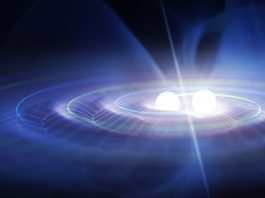For the first time, scientists have created a quantum tornado to mimic a black hole in superfluid helium.
Led by the University of Nottingham, in collaboration with King’s College London and Newcastle University, researchers have created a quantum tornado to see how black holes behave.
The team created a giant quantum vortex within superfluid helium that is chilled to the lowest possible temperatures.
Through the observation of minute wave dynamics on the superfluid’s surface, the research team has demonstrated that quantum tornadoes mimic gravitational conditions near rotating black holes.
The research was published in the journal Nature.
Superfluid helium acts as a stabilising force
The team created a bespoke cryogenic system capable of containing several litres of superfluid helium at temperatures lower than -271°C.
Liquid helium acquires unusual quantum properties at this temperature.
These properties act as a barrier to the formation of giant vortices in other quantum fluids like ultracold atomic gases or quantum fluids of light.
The system shows that the interface of superfluid helium acts as a stabilising force for these objects.
The paper’s lead author, Dr Patrik Svancara from the School of Mathematical Sciences at the University of Nottingham, said: “Superfluid helium contains tiny objects called quantum vortices, which tend to spread apart from each other.
“In our set-up, we’ve managed to confine tens of thousands of these quanta in a compact object resembling a small tornado, achieving a vortex flow with record-breaking strength in the realm of quantum fluids.”
Parallels between quantum tornadoes and the influence of black holes
The team found interesting parallels between the vortex flow and the gravitational influence of black holes on the surrounding spacetime.
The achievement provides the opportunity for simulations of finite-temperature quantum field theories within the realm of curved spacetimes.
Professor Silke Weinfurtner, leading the work in the Black Hole Laboratory where this experiment was developed, said: “When we first observed clear signatures of black hole physics in our initial analogue experiment back in 2017, it was a breakthrough moment for understanding some of the bizarre phenomena that are often challenging.
“Now, with our more sophisticated experiment, we have taken this research to the next level, which could eventually lead us to predict how quantum fields behave in curved spacetimes around astrophysical black holes.”
The research has received £5m in funding from the Science Technology Facilities Council.
The project has also been supported by both the UKRI Network grant on Quantum Simulators for Fundamental Physics and the Leverhulme Research Leaders Fellowship held by Professor Silke Weinfurtner.









